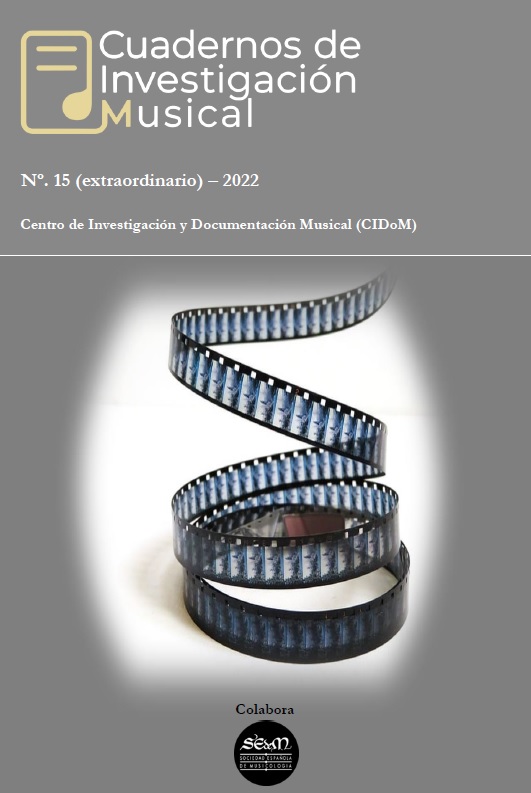“It’s music, a human thought structure” Music as a technology of cyborgs in Spanish cyberpunk films
Main Article Content
Abstract
In this article, I discuss how two Spanish cyberpunk films, Eva and Autómata, imagine cyborgs and represent music as a part of their relational capacities with artifacts, entities, and environments. Through an interconnected analysis, I present the idea of musical ecology as an articulation between cyberpunk sonic conventions and pre-existing music. Another topic is the post-human subject, which I name the assemblage music-cyborgs where sonic phenomena are an intrinsic and active agent of their construction. The main conclusion is that music is a metaphor for humanity and a channel to new modes of subjectivity intended to reconfigure musical production, listening, interpretation and pleasure.
Article Details
Los autores de los artículos mantienen el copyright, no recibirán ninguna contraprestación económica por el trabajo y el mismo siempre será reconocido como exclusivamente suyo. La revista se compromete a proteger la integridad y originalidad del artículo, así como los derechos de autor que correspondan. Los autores son los únicos responsables del material, textos e imágenes que utilizan en sus respectivos trabajos, debiendo respetar siempre los derechos de autor de terceras personas, por lo que la revista no se hace responsable de lo contenido en este tema respecto al trabajo de los autores.
References
Barham, J. (2000). Scoring Incredible Futures: Science-Fiction Screen Music, and “Postmodernism” as Romantic Epiphany. The Musical Quarterly, 91(3-4), pp. 240-274.
Bartkowiak, M. J. (2009). Introduction. In M. J. Bartkowiak (Ed.). Sounds of the Future: Essays on Music in Science Fiction Film (pp. 1-9). Jefferson: McFarland & Company, Inc., Publishers.
Braidotti, R. (2013). The Posthuman. Cambridge: Polity Press.
Brett, P. (2006). Musicality, Essentialism, and the Closet. In P. Brett, E. Wood & G. C. Thomas (Eds.). Queering the Pitch: The New Gay and Lesbian Musicology (pp. 9-26). New York and London: Routledge.
Buhler, J. (2019). Theories of the Soundtrack. Oxford: Oxford University Press.
DeNora, T. (2000). Music In Everyday Life. Cambridge: Cambridge University Press.
DeNora, T. (2011). Music-in-Action: Selected Essays in Sonic Ecology. London and New York: Routledge.
Fink, R. (2005). Repeating Ourselves: American Minimal Music as Cultural Practice. Berkeley: University of California Press.
Frith, S. (2003). Music and Everyday Life. In M. Clayton, T. Herbert & R. Middleton (Eds.). The Cultural Study of Music: A Critical Introduction (pp. 92-101). New York and London: Routledge.
Haraway, D. (2013). Staying with the Trouble: Making Kin in the Chthulucene. Durham and London: Duke University Press.
Hoeckner, B. (2007). Transport and Transportation in Audiovisual Memory. In D. Goldmark, L. Kramer & R. Leppert (Eds.). Beyond the Soundtrack: Representing Music in Cinema (pp. 163-183). Berkley, Los Angeles and London: University of California Press.
Kassabian, A. (2001). Hearing Film: Tracking Identifications in Contemporary Hollywood Film Music. New York and London: Routledge.
Lieb, K. J. (2018). Gender, Branding, and the Modern Music Industry. New York and London: Routledge.
Loza, S. (2001). Sampling (Hetero)Sexuality: Diva-Ness and Discipline in Electronic Dance Music. Popular Music, 20(3) [Gender and Sexuality (Oct., 2001)], pp. 349-357.
Malhado, A. (2021). A música na construção de práticas representacionais e estereotipadas do pós-humano em audiovisuais. In A. B. de Oliveira, A. C. Pereira, A. Taunay, L. Rosa & N. Araújo (Eds.). Cinema e Outras Artes IV: Diálogos e Inquietudes Artísticas (pp. 165-190). Covilhã: LabCom.
Marsh, C. & M. West. (2003). The Nature/Technology Binary Opposition Dismantled in the Music of Madonna and Björk. In R. T. A. Lysloff & L. C. Gay Jr. (Eds.). Music and Technoculture (pp. 182-203). Middletown: Wesleyan University Press.
McClary, S. (2000). Conventional Wisdom: The Content of Musical Form. Berkeley: University of California Press.
Neil L. (2009). Danny Elfman: ‘Funny Circus Mirrors’. In G. Harper (Ed.). Sound and Music in Film and Visual Media (pp. 524-532). New York: Bloomsbury.
Schmidt, L. M. (2009). A Popular Avant-Garde: The Paradoxical Tradition of Electronic and Atonal Sounds in Sci-Fi Music Scoring. In M. J. Bartkowiak (Ed.). Sounds of the Future Essays on Music in Science Fiction Film (pp. 22-43). Jefferson: McFarland & Company Inc. Publishers.
Shine, J. (2021). There’s meth in the madness: music and incongruence in AMC’s Breaking Bad. In A. Cascelli & D. Condon (Eds.). Experiencing Music and Visual Cultures: Threshold, Intermediality, Synchresis (pp. 153-166). London and New York: Routledge.
Short, S. (2005). Cyborg Cinema and Contemporary Subjectivity. New York: Palgrave MacMillan.
Small, C. (1999). Musicking: The Meanings of Performing and Listening. Middletown: Wesleyan University Press.
Smith, J. (2008). Vocal Tracks: Performance and Sound Media. Berkeley, Los Angeles and London: University of California Press.
